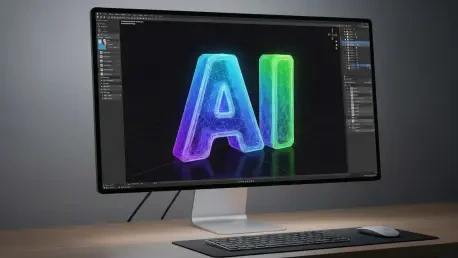In an era where digital design dictates market success, the demand for tools that can transform abstract ideas into tangible visuals has never been higher, and countless designers and marketers face the challenge of crafting high-fidelity prototypes under tight deadlines. Often limited by resources for professional photography or complex software, they struggle to bring concepts to life quickly. Enter Gempix-2, also dubbed Nano Banana 2, an unreleased AI model speculated to be part of Google DeepMind’s Gemini 3.0 Pro Image lineup. This technology promises to revolutionize visual prototyping by bridging the gap between creative vision and polished output, as glimpsed through early leaks on platforms like Media.io and Gempix2.ai. This review delves into the potential of Gempix-2, exploring its standout features and the transformative impact it could have on design and marketing industries.
Unveiling the Core Capabilities of Gempix-2
Gempix-2 emerges as a cutting-edge tool in AI-driven image generation, built on the robust Gemini 3.0 Pro Image framework. Although still in a pre-release phase, snippets of its capabilities shared by early testers highlight significant advancements over existing models. These include higher resolution outputs, refined text rendering, and intuitive editing features, positioning it as a potential cornerstone for creators seeking efficiency without sacrificing quality.
The technology’s core strength lies in its ability to interpret intricate prompts and translate them into detailed visuals. Unlike earlier AI tools that often struggled with nuanced instructions, Gempix-2 appears to grasp creative intent with remarkable precision. This leap forward hints at a future where designers can iterate concepts in minutes rather than hours, a game-changer for fast-paced industries.
Speculation around Gempix-2 continues to build, fueled by brief previews that surfaced online. While official confirmation from Google DeepMind remains pending, the buzz suggests that this model could set a new standard for visual prototyping, particularly for professionals in need of seamless, high-quality mockups and renders.
Key Features Redefining Visual Prototyping
Ultra-High Resolution: 2K Native with 4K Upsampling
One of the most striking aspects of Gempix-2 is its capacity to produce images at a native 2K resolution, with the option to upscale effortlessly to 4K. This feature ensures that every visual, from product mockups to advertising assets, boasts exceptional clarity and detail. For industries where first impressions matter, such as e-commerce, this level of precision can elevate the perceived value of a product.
The implications of this resolution capability are profound for design workflows. Professionals can now generate ultra-high-definition visuals that rival studio photography, eliminating the need for costly setups or time-intensive edits. This advancement makes Gempix-2 a vital asset for creating polished, professional-grade prototypes on demand.
Beyond aesthetics, the upsampling technology maintains image integrity, avoiding the pixelation often seen in lesser models. This reliability ensures that designers can confidently use outputs for client presentations or marketing campaigns, knowing that the quality will meet exacting standards.
Precision Text Rendering with Multi-Language Support
Another leap forward with Gempix-2 is its enhanced text-to-image rendering, which captures complex prompts with pinpoint accuracy. Whether integrating specific fonts, styles, or placements, the model ensures that textual elements blend seamlessly into the overall design. This precision is critical for projects like infographics or user interface layouts where text plays a central role.
Equally impressive is the addition of multi-language support, catering to the needs of global brands. This feature enables the creation of localized content that resonates with diverse audiences, from promotional materials to region-specific packaging. Such versatility positions Gempix-2 as a tool for inclusive design on a worldwide scale.
This capability addresses a long-standing pain point in AI image generation—ensuring text doesn’t appear as an afterthought. By prioritizing accuracy and cultural relevance, Gempix-2 offers a solution that aligns with the demands of multinational marketing strategies, making it indispensable for cross-border campaigns.
Sophisticated Editing: Multi-Step Fusion and 3D Spatial Control
Gempix-2 introduces advanced editing tools that redefine how creators interact with AI-generated visuals. Features like multi-step fusion allow for intricate layering and blending of elements, while 3D spatial adjustments enable precise control over perspective, lighting, and depth. These tools simulate real-world conditions with striking realism.
Such functionalities empower users to craft dynamic scenes and lifelike 3D models without requiring specialized software or expertise. For product designers, this means the ability to visualize items from multiple angles or under varied lighting, enhancing the prototyping process with unparalleled flexibility.
The practical benefits extend to industries beyond traditional design, including virtual reality and gaming, where spatial accuracy is paramount. By offering these sophisticated controls, Gempix-2 paves the way for more immersive and realistic digital experiences, pushing the boundaries of what AI can achieve in visual creation.
Consistency in Character and Element Rendering
Maintaining visual consistency across multiple images is a challenge that Gempix-2 tackles with finesse. Whether rendering recurring characters for storytelling or uniform product elements for branding, the model ensures that details like proportions and expressions remain steady. This reliability is crucial for cohesive campaigns.
For creators working on serialized content or product lines, this feature eliminates the frustration of mismatched visuals. It supports the development of a unified visual identity, a key factor in building brand recognition and trust among consumers.
The technology’s ability to preserve continuity also streamlines iterative design processes. Teams can generate variations of a concept without worrying about losing the core aesthetic, saving time and ensuring that every output aligns with the overarching vision of a project.
Contextual Design with Enhanced World Knowledge
Leveraging the Gemini 3.0 Pro Image framework, Gempix-2 demonstrates a deeper understanding of global contexts, enabling the creation of culturally relevant visuals. This enhanced world knowledge ensures that designs reflect authentic environments and resonate with specific demographics, a vital edge for regional marketing.
This feature proves invaluable for brands expanding into new markets, allowing them to tailor imagery that feels local and relatable. From outdoor signage to product displays, Gempix-2 can adapt visuals to match cultural aesthetics, enhancing engagement with target audiences.
By embedding such contextual awareness, the model addresses the often-overlooked aspect of localization in design. It offers a pathway to create content that not only looks appealing but also connects on a deeper level, fostering stronger ties with diverse consumer bases.
Practical Applications Across Industries
Gempix-2 showcases immense potential in transforming workflows across various sectors, particularly in e-commerce, user experience design, and marketing. Its ability to produce high-resolution product renders rivals professional photography, enabling online retailers to create compelling listings swiftly. This efficiency can significantly shorten time-to-market for new launches.
In the realm of UI and device interface prototyping, the model’s knack for simulating digital screens and layouts stands out. Designers can visualize app interfaces or device mockups with realistic detail, facilitating rapid iteration and refinement. This application streamlines the development process for tech products, ensuring concepts are tested effectively.
For localized marketing, Gempix-2’s contextual understanding allows brands to craft visuals tailored to specific regions. Whether adapting imagery for cultural nuances or geographic settings, the technology supports global campaigns with precision, reducing reliance on multiple design teams and enhancing campaign relevance.
Navigating Gempix-2 via Gempix2.ai Platform
Accessing Gempix-2 through Gempix2.ai offers a straightforward experience, designed to cater to both novices and seasoned creators. The platform’s intuitive interface simplifies the process of generating prototypes, starting with a visit to the site where users can explore the tool’s capabilities. Its accessibility makes it a promising hub for AI-driven design.
Users can begin by uploading reference images or inputting detailed text prompts to describe their vision. The system processes these inputs rapidly, producing initial mockups that can be refined through adjustments to lighting, angles, or backgrounds. This quick turnaround is ideal for tight schedules.
Once satisfied with the output, sharing or downloading results is seamless, facilitating collaboration and integration into broader workflows. The speed and ease of use underscore Gempix-2’s potential to become a staple in creative toolkits, pending its full public release and further platform enhancements.
Challenges and Limitations to Address
Despite the excitement surrounding Gempix-2, several hurdles remain due to its pre-release status. Technical constraints, such as processing demands or compatibility issues, could limit accessibility for some users. Additionally, the lack of official documentation raises questions about the full scope of its capabilities.
Ethical and regulatory concerns around AI-generated content also loom large, particularly regarding copyright and authenticity. These issues may slow market adoption until clear guidelines are established, a critical step for ensuring responsible use of such powerful technology.
Lastly, the speculative nature of current information means that expectations must be tempered. Until Google DeepMind provides confirmation, uncertainties persist about performance consistency and integration, necessitating patience and vigilance from potential adopters.
Future Horizons for AI in Visual Design
Looking ahead, Gempix-2 holds the promise of reshaping creative industries through continuous advancements in AI image generation. Anticipated updates could include even higher resolutions or more nuanced contextual rendering, further streamlining design processes. Such developments would solidify its role as a transformative tool.
The integration of this technology into everyday platforms like Gempix2.ai suggests a democratized future for high-end design. As accessibility improves over the coming years, from now through 2027, smaller businesses and independent creators could harness professional-grade tools, leveling the playing field.
Moreover, Gempix-2 might inspire broader innovations in how AI intersects with creativity, potentially influencing fields like augmented reality or interactive media. Its evolution could redefine the boundaries of digital prototyping, setting new benchmarks for what technology can achieve in visual storytelling.
Final Thoughts on Gempix-2’s Journey
Reflecting on the exploration of Gempix-2, it becomes evident that this AI model carries immense potential to redefine visual prototyping, even as it lingers in a pre-release state. Its leaked previews and early tester feedback paint a picture of a tool that excels in resolution, precision, and contextual design, capturing the imagination of industries eager for innovation. The capabilities demonstrated through platforms like Gempix2.ai hint at a seismic shift in creative workflows.
Moving forward, stakeholders need to prioritize addressing the ethical and technical challenges that surface during initial discussions. Establishing robust frameworks for responsible use and ensuring broader accessibility stand out as critical next steps. Engaging with regulatory bodies to clarify guidelines on AI-generated content also emerges as a necessary action to foster trust.
As anticipation builds for an official release, the focus shifts to how Google DeepMind can refine Gempix-2 to meet diverse user needs. Collaboration with design communities to test and iterate on the technology offers a pathway to maximize its impact. Ultimately, the journey of Gempix-2 underscores a pivotal moment for AI in design, urging all involved to shape its integration thoughtfully for lasting benefit.









